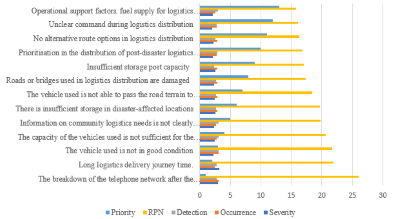Risk Analysis of Post-Disaster Logistics Distribution Failure
DOI:
https://doi.org/10.24036/cived.v11i3.603Keywords:
Risk Process Distribution Logistics, Risk Management, FMEA MethodsAbstract
In conducting logistical activities of disaster relief in natural disaster management. it is often not possible to implement as it should. and there are always potential risks that arise. One of the problems faced is the delayed distribution of post-disaster logistics. Therefore. risk management is necessary so that disaster relief logistics activities can run well. In addition. there is a need for a risk mitigation strategy to mitigate potential risks in the post-disaster logistics distribution process. The study aims to identify potential risks to post-disaster logistics distribution activities and find out which risk management strategies are a priority to address immediately. Failure Mode and Effect Analysis (FMEA) is a systematic approach to identifying failures and giving a value or score to each risk. From the results of the study. 32 potential risks occurred. As a result. 13 risks were identified with RPN values above critical point values. Thus. 13 were obtained as priority management risks. where the risks with the top 3 RNA values are Disruption of the post-earthquake telephone network Difficulty coordination of the logistics team with a rating of 25.98. Long logistic delivery travel time with a value of 21.86. and Condition of the vehicle used is not good with a score of 21.66. Thus. for 13 of these risks. mitigation is carried out for treatment priorities. Risk management strategies are applied to risks that have RPN values above critical values to minimize the impact.
Downloads
References
. Agus. I.. & Arkom. K. (2012). Konstruksi Masyarakat Tangguh Bencana. Bandung: PT Mizan Pustaka.
. M. Dolores and C. Tongco, “Definition of Purposive Sampling,” A J. Plants, People Appl. Res., vol. 5, 2007.
. K. Nikolopoulou, “What Is Purposive Sampling: Definition & Examples,” Www.Scribbr.Com. 2022.
. A. Crossman, “Purposive Sampling - Definition and Types,” Thoughtco. 2020.
. B. M. Adji, B. Istijono, T. Ophyandri, and B. Hidayat, “Implementation empowering communities in small scale irrigation projects during Covid 19 Pandemic in Padang and Padang Pariaman District,” in IOP Conference Series: Earth and Environmental Science, 2021. doi: 10.1088/1755-1315/708/1/012078.
. B. Martanto, B. Istijono, T. Ophiyandri, B. Hidayat, and M. Rahendra, “The Implementation of Health Protocol in Irrigation Small Scale Project in Padang Pariaman District,” vol. 13, no. 4, pp. 1463–1471, 2023.
. M. Alruqi, M. Baumers, D. Branson, and R. Farndon, “A Structured Approach for Synchronising the Applications of Failure Mode and Effects Analysis,” Manag. Syst. Prod. Eng., vol. 29, no. 3, 2021, doi: 10.2478/mspe-2021-0021.
. G. Ma and X. Pan, “Research on a visual comfort model based on individual preference in china through machine learning algorithm,” Sustain., vol. 13, no. 14, 2021, doi: 10.3390/su13147602.
. K. O. Kim and M. J. Zuo, “General model for the risk priority number in failure mode and effects analysis,” Reliab. Eng. Syst. Saf., vol. 169, 2018, doi: 10.1016/j.ress.2017.09.010.
. K. S. Chin, Y. M. Wang, G. Ka Kwai Poon, and J. B. Yang, “Failure mode and effects analysis using a group-based evidential reasoning approach,” Comput. Oper. Res., vol. 36, no. 6, 2009, doi: 10.1016/j.cor.2008.05.002.
. S. Kmenta and K. Ishii, “SCENARIO-BASED FMEA: A LIFE CYCLE COST PERSPECTIVE,” in Proceedings of the ASME Design Engineering Technical Conference, 2000. doi: 10.1115/DETC2000/RSAFP-14478.
. Sugiyono (2016). Metode Penelitian Kuantitatif, Kualitatif, dan R&d. Bandung: Alfabeta CV.
. McDermott, R. E., Mikulak, R. J., & Beauregard, M. R. (2009). The Basics Of FMEA. 2nd Edition. US: CRC Press Taylor and Francis Group.

Downloads
Published
How to Cite
Issue
Section
License
Copyright (c) 2024 Wenny Herdianti, Bayu Martandto Adji, Taufika Ophiyandri

This work is licensed under a Creative Commons Attribution 4.0 International License.







2.jpg)
